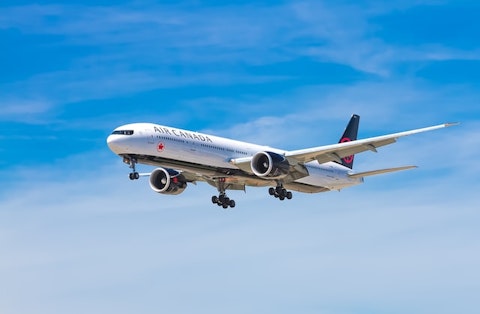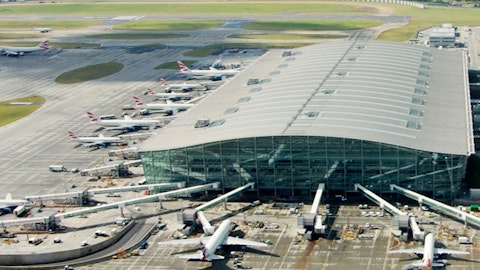Grupo Aeroportuario del Centro Norte, S.A.B. de C.V. (NASDAQ:OMAB) Q4 2022 Earnings Call Transcript February 17, 2023
Operator: Greetings and welcome to the Grupo Aeroportuario del Centro Norte OMA Fourth Quarter 2022 Earnings Call. As a reminder, this conference is being recorded. I would now like to turn the conference over to your host, Emmanuel Camacho, Investor Relations Officer. Thank you. You may begin.
Emmanuel Camacho: Thank you, Melissa and good morning, everyone. Welcome to OMA’s fourth quarter 2022 earnings conference call. Joining me this morning are CEO, Ricardo Duenas and CFO, Ruffo Perez Pliego. Please be reminded that certain statements made during the course of our discussion today may constitute forward-looking statements which are based on current management’s expectations and beliefs and are subject to a number of risks and uncertainties that could cause actual results to differ materially, including factors that may be beyond our control. And with that, I will turn the call over to Ricardo Duenas for his opening remarks.
Ricardo Duenas: Thank you, Emmanuel. Good morning, everyone. We appreciate you joining us today. This morning, I will highlight several reporting events and milestones, then I will briefly review our operational performance and financial results. Finally, we will be pleased to answer your questions. First of all, in December 2022, VINCI Airports finalized the process for the acquisition of 29.99% of Series B and Series BB shares of OMA which made VINCI Airports, our largest shareholder. As part of the process prior to the closing of the transaction, OMA held a shareholder meeting in which 6 new proprietary members for the Board — of the Board. All of them part of the VINCI Group were appointed and the resignation of the 6 former proprietary members of our Board was accepted.
I would like to express my gratitude to our former Board members and I would also like to welcome our 6 new Board members which I am certain will contribute to OMA’s value creation across the Board. VINCI Airports is the world’s largest private airport operator, managing 65 airports in 12 countries and served 255 million passengers in 2019. Some of the assets management of VINCI airports include London Gatwick and Lisbon airports. At OMA, we expect to leverage from VINCI Board expertise in managing and development in port infrastructure and to adopt best practice to provide a world-class service to our passengers. In other news, in January, OMA was recognized for the second year in a row as 1 of the 12 Mexican companies to be part of the 2023 Bloomberg gender equality index.
We are proud to be recognized as a company committed to fostering gender equality, inclusion and diversity across our different teams within the company. Finally, last Monday, we held an ordinary shareholders’ meeting where shareholders approved the declaration and payment of ordinary cash dividend to shareholders up to MXN1.45 billion and delegated to the Board the power to the amount and dates of payments. Yesterday, we published a press release announcing that we will distribute an extraordinary dividend of MXN1.45 billion to shareholders on March 2 of this year. Payment of this dividend reinforces our objective of optimizing our capital structure. Moving on to annual performance. OMA delivered a strong performance in the fourth quarter and for the full year 2022.
For the full year, we served records for passenger traffic, revenues, adjusted EBITDA, adjusted EBITDA margin and consolidated net income. I will start by discussing our full year 2022 highlights and then I will move on to our main 4Q ’21 results. In 2022, our positive passenger traffic performance reflects the external recovery in volumes from business-related routes as compared to 2021. The routes were the largest passenger in were Monterrey to Mexico City, Monterrey to Guadalajara and Ciudad Juárez to Mexico City. All of them business-oriented groups. Also, posting strong increases in 2022 were the Monterrey-Tijuana and the Monterrey-Cancún routes. In total, these 5 routes jointly added a total of 1.9 million additional passengers, representing 36% of the total 5.2 million passenger increase during the year.

Photo by John McArthur on Unsplash
Additionally, during the year, we opened 31 new routes, of which 20 were international. We believe there is room for strong and continued passenger traffic growth prospects as business opportunities in Mexico continue to expand. As a result of our solid performance, 12-month passenger traffic stood at a new record level of 23.2 million passengers which represents a 29% growth as compared to 2021 and has outpaced by 0.2% our 2019 levels. I am proud to say that the effects of the pandemic and traffic performance are clearly behind this. On the financial performance front, aeronautical and non-aeronautical revenues reached record levels in 2022, growing each by 22% versus 2019. As a result, our adjusted EBITDA for the year was MXN7.1 billion, 27% above 2019 and we set a new record for our adjusted EBITDA margin which expanded to 76.3%, aided importantly by our continued efficiency in our cost and expense structure.
Consolidated net income for the year stood at MXN3.9 billion, an increase of 21% versus 2019. During the year, we distributed value to our shareholders by paying out an aggregate of MXN6.7 billion in dividend throughout the year and disbursed a total of MXN3.3 billion in our master development program commitments and on our strategic CapEx. I will now review our fourth quarter operational performance. In fourth quarter of ’22, OMA’s passenger traffic reached 6.5 million, an increase of 20.7% versus fourth quarter of ’21 and was 8.7% above the same quarter of 2019. The airports that led passenger traffic growth during the quarter were Monterrey, Ciudad Juárez, Culiacán and Chihuahua. And the route for the strongest traffic growth compared to fourth quarter of ’21, all considered mainly business routes were Monterrey to Mexico City, Toluca, Tijuana, Guadalajara routes.
On the aggregate, these routes added 349,000 additional passengers in the quarter, an increase of 33% versus fourth quarter of ’21. Performance in fourth quarter ’22 confirms the current positive momentum of business travel segment in OMA’s portfolio. Primarily as a result of the strongest passenger traffic performance, our aeronautical revenue grew by 26% in the quarter versus the fourth quarter of ’21 to MXN2 billion. On the commercial front, revenues increased 35% compared to the fourth quarter of ’21, driven by parking, car rental, restaurants, VIP lounges and retail. Occupancy rate for commercial space stood at 93.5% at the end of the year. Diversification revenues increased 24%. Our hotel services and OMA Carga contributed most to this growth.
In the fourth quarter of 2022, occupancy rate of our Terminal 2 NH collection was 81.5%, while the Hilton Garden Inn Hotel had an occupancy rate of 75.1%. OMA Carga delivered strong results went more as revenues increased 20% versus fourth quarter of ’21, mainly driven by the strong operation of air and ground import cargo. On the capital expenditure front, total investments in the quarter, including MDP investments, major maintenance and strategic investments were MXN1.2 billion. During the quarter, some of the most relevant projects we’re working are we expand modeling of the Monterrey Airport Terminal A building as well as the Ciudad Juárez and Culiacán terminal buildings. Reconfiguration of the Mazatlán terminal building, major rehabilitations of platforms and taxi ways in several airports and platform reconfiguration at the Monterrey Airport.
And with that, I will now turn the call over Ruffo Perez Pliego for more detail on our financial highlights for the quarter.
Ruffo Perez Pliego: Thank you, Ricardo and good morning to everyone. I will briefly review our financial results and then we’ll open the call for your questions. Turning to OMA’s fourth quarter financial results. Aeronautical revenues increased 26% versus Fourth quarter of 2021, driven by the 21% increase in passenger traffic and increase in our aeronautical tariffs implemented in the first quarter of last year. Non-aero revenues increased also 26.0%. Commercial revenues increased 34.6% and the categories with the highest growth were car parking, car rental, restaurants, VIP lounges and retail. Parking revenues increased 46% due to higher penetration in the Chihuahua, Monterrey and Culiacán airports as a result of improved business dynamism in those airports.
Car rentals, restaurants and retail increased 58%, 28% and 22%, respectively, mainly due to higher revenue sharing and the opening of new commercial spaces. VIP lounges increased 48% due primarily to the recognition of revenues from a direct operation as well as an increase in number of users of the OMA Premium Lounges. Diversification activities increased 24%, reflecting the strong hotel operations OMA Carga’s performance. Total aeronautical and non-aero revenues were MXN2.6 billion in the quarter and grew 26% relative to the 4Q of ’21. Construction revenues increased 71% as a result of higher MDP investment execution. The cost of airport services and G&A expense increased 15.9% relative to 4Q ’21, mainly due to an increase in payroll expense as a result primarily of increased headcount, higher salaries versus last year and provisions, including statutory profit shares.
Other increases came at the contracted services line item which grew due to overall higher activity in our airports. And insurance which was partially offset by lower electricity expense as a result of a higher proportion of energy supplied from green sources. During the quarter, solar panel’s operating in our 13 airports generated 17% of OMA’s energy consumption. And our airports were supplied more wind energy as compared to 4Q ’21. Overall, during the quarter, 95% of our energy came from green sources. Major maintenance provision was MXN42 million as compared to MXN118 million in 4Q ’21. OMA’s fourth quarter adjusted EBITDA reached MXN1.9 billion and the adjusted EBITDA margin was 75.8%. Our financing expense reached MXN204 million, mainly due to higher interest expense as a result of additional debt issuance and the higher cost of debt.
Consolidated income was MXN1.1 billion in the quarter, an increase of 11.8% relative to 4Q ’21. Turning to our cash position. Cash generated from operating activities in the fourth quarter amounted to MXN1.6 billion and cash at the end of the quarter stood at MXN3.4 billion. At the end of the year, the total debt amounted to MXN10.2 billion and our net debt to adjusted EBITDA ratio stood at 1x. In February of this year, we have started the process for the refinancing of our bonds maturing in 2023. The refinancing is expected through the issuance of a new bond in the local markets and the terms and conditions are still being worked out and we expect the issuance to close early in March. This concludes our prepared remarks. Operator, please open the call for questions.
See also 25 Best Countries for a Comfortable Retirement and 10 Best Annuity Companies in the US.
Q&A Session
Follow Grupo Aeroportuario Del Centro N (NASDAQ:OMAB)
Follow Grupo Aeroportuario Del Centro N (NASDAQ:OMAB)
Operator: Our first question comes from the line of Rodolfo Ramos with Bradesco BBI.
Rodolfo Ramos: Just a couple on my side. The first one is, can you give us a little bit of your expectation in terms of your cost and G&A for this year. There’s a lot of moving parts. You have payroll increasing sharply and then you have these lower costs on the utility side. But I just wanted to see whether you expect this number to be around MXN400 million per quarter this year. And perhaps if you can elaborate on some of the cost pressures that the companies are seeing, whether it’s vacation days, pension contributions. If you can talk about that on your outlook for 2023, that would be very much appreciated. And the second question is on — and alluding to some of your initial remarks is on this value creation from having VINCI as a controller and on the Board.
If you can perhaps talk a little bit or elaborate a little bit more on where are the areas of opportunity that you see? You’ve been a couple of months formally — having formally closed this control — this change in control. So just wanted to see what are the priorities, some of the — maybe if there’s any operational changes that we can expect or something more big picture there, that would be great.
Ricardo Duenas: Sure. Rodolfo, let me — I’ll take the second one. I’ll leave Ruffo to answer the first one. As for VINCI, we expect to leverage its operational and commercial expertise to drive value creation at OMA. Some examples that have been identified on the bill of OMA strategy of recent years are to continue to develop air service developments and increase international passenger mix, increase non-air revenues to improve commercial offering and diversification developments, leverage VINCI expertise in planning out for growth and expansion and capital optimization, among others. And as for management, they have given a lot of confidence to their current management and we’re working along with that very well. Ruffo, do you want to answer the cost structure?
Ruffo Perez Pliego: Thank you, Ricardo. Rodolfo, in terms of cost side, I think we should expect mostly inflationary increases going forward. The big surge in passenger growth that we experienced last year only had some pressure in our operational costs. But we expect stability impacting growth in the coming months, we should also expect the same in cost side.
Operator: Our next question comes from the line of Anton Morganti with GBM.
Unidentified Analyst: Congrats on the results. Just a quick one. I mean I know that Aeromar is not significant on a consolidated basis but I do know that they have strong operations in Acapulco and Zihuatanejo airports. I was just wondering if you expect to see any impacts in those airports for your operations going forward or if any airline already took that market share?
Ricardo Duenas: Thank you, Anton. We’re going to anticipating this unfortunate event for some time. The participation of Aeromar was very small, 0.6% of the traffic. And the routes that they were covering that they didn’t have any exclusivity. So that means there were other airlines covering that route. So we expect all the traffic — or the few traffic that was covered by Aeromar will be captured very quickly by the rest of the airlines. So in short, I don’t see any impact going forward as a result of this unfortunate event.
Unidentified Analyst: Okay. And just another quick one. What are you seeing in terms of trends for business travel? Talking about all of these nearshoring boom. Are you actually seeing some? I mean, Monterrey traffic has increased but do you see this related to that? Or if you could provide some of your color on that?



